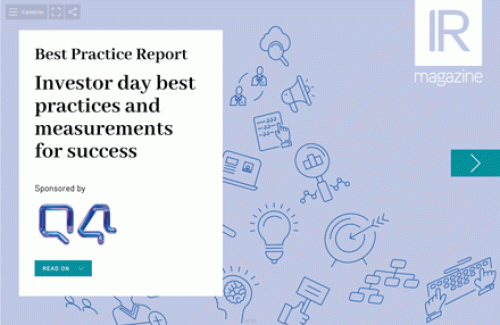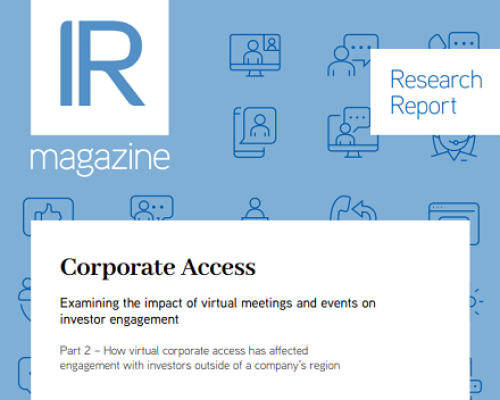A new UK report that outlines how companies and investors can boost engagement and combat short-termism
It’s been five years since the 2008 financial crisis led to an era of finger-pointing and acrimony that highlighted what some saw as a disturbing disconnect between a number of UK companies and those who invest in them. Since then, several efforts have been launched to evaluate and improve those relationships, including the groundbreaking July 2012 report by the economist John Kay, which highlighted an increasing drift by investors toward short-termism.
In March this year came the latest – and perhaps most concrete – guidance on how IR professionals and corporate management, in collaboration with investors, might combat this trend. ‘Enhancing stewardship dialogue’ grew out of recommendations from yet another earlier report: ‘2020 stewardship: improving the quality of investor stewardship’, produced in March 2012 by six institutional investors. That report emphasizes the need for a good practice guide that spells out how best to conduct investor-company dialogues and follow them up with feedback from those sitting on both sides of the table, in order to improve future interactions. The resulting practice guide, ‘Enhancing stewardship dialogue’, provides advice on everything from how to develop a constructive engagement strategy and how to set up and run a productive meeting with investors to deciding who should attend.
‘We can do better,’ writes Sir John Egan, chair of the working group of companies and institutional investors that created the report, in the foreword. ‘But as this guidance points out, the current system can work well when companies and/or investors try hard to make it work.’
The long game
Perhaps the most important part of the guidance is a series of recommendations detailing what areas a discussion on long-term strategy and performance might cover. The underlying goal is to help IR professionals and company leadership to identify and cultivate a core group of long-term investors, and focus consistent attention on conveying the factors that create and destroy value.
‘Companies need to move away from a dialogue that focuses simply on the numbers and on-the-spot evaluations that allow analysts to issue buy, hold or sell recommendations,’ says Seamus Gillen, policy director for the Institute of Chartered Secretaries and Administrators, which drafted the report with the help of Egan’s steering committee. Rather, he suggests, companies need to strengthen the conversation that actually allows investors to understand ‘the value creation narrative, what the strategy is, what the drivers are to value and the risk to those drivers, and therefore what the longer-term prospects are. If analysts and investors understand better, they can place the short-term performance into a wider understanding of the market and how the company is going to perform.
‘But we know from practical experience that the discussion of long-term strategy does not happen. It needs to happen more often and it needs to be better,’ adds Gillen.
‘Most meetings tend to be dominated by discussion of the latest quarterly results,’ agrees Peter Butler, founder and partner emeritus of the Governance for Owners 2020 Stewardship Working Party. ‘What we’re saying is that, firstly, every company should have an engagement strategy that it plans with its major shareholders and, secondly, this strategy should make provision at least once a year for the companies’ investors to meet to discuss that strategy and long-term performance, and the governance arrangements in place to sustain that performance.’
Not all in it together
Of course, reversing the trend toward short-termism noted by Kay does not depend solely on companies. Many issuers, Butler notes, are dealing with the ‘absentee landlord’ syndrome.
‘When the landlord doesn’t look after a property, it gets trashed,’ he explains. ‘And although the companies have done a lot to move governance forward, the institutional investors haven’t on the whole done so much. There has been a lot of grumbling about the quality of stewardship and the lack of interest at some institutional investors when it comes to getting involved in these longer-term discussions. We recognize there are problems with both the quantity and quality of stewardship.’ The recommendations in the latest report are ‘all pretty basic,’ Butler adds, but ‘we found that a lot of basic things weren’t being done by enough institutional investors.’
Anita Skipper, corporate governance adviser at Aviva Investors, who also helped prepare the report, notes that ‘if you have a proper understanding between the company and investors, you are more likely to develop more loyal investors’, although she adds that you can still have meetings where nothing happens.
‘This is a simple guide,’ says Skipper. ‘[Investors should] be prepared and know what questions to ask. And companies should decide what is important to tell investors. It’s not just about the EPS targets for the next three months. If you develop a discussion, you will also encourage a more long-term approach with your investors. Within the whole discussion of strategy and the long term, you can incorporate discussions about remuneration and board structure.
‘You are letting your investors know, This is our strategy for the next five to 10 years, this is how we incentivize our board, this is how we’re going to run the company. It gives the investors more confidence, so they are more likely to invest – and stay with you.’
John Gollifer, general manager of the UK’s Investor Relations Society, notes that it is incumbent upon IR professionals to help implement these new recommendations. ‘We have formal means of communication, quarterly reporting, annual reports, AGMs,’ he says. ‘But there is a dialogue, an engagement that should be going on over and above that, all the way up to the board, even the chairman. Typically the chairman and non-executive directors don’t get involved except at more formal reporting opportunities.
‘One of the points is that IR should be able to manage a whole calendar in terms of different audiences and who attends different meetings. Clearly, part of the dialogue must involve them. And often it’s more sensible to take it out of the formal setting of the AGM.’
Both sides, Gollifer adds, should be able to give feedback – including the companies, which sometimes arrive at meetings to find the wrong people on the other side of the table. ‘Sometimes investors aren’t up to scratch in terms of what they are talking about in meetings, in terms of preparation, in terms of having the right people in the meeting,’ he says. ‘You need to be able to express that as feedback to the buy side.’
Report recommendations
|
Action pointsA company to-do list compiled from Enhancing stewardship dialogue:1. Develop an engagement strategy. 2. Get the housekeeping right, including inviting the right organizations and the right people, keeping clear records and reviewing governance arrangements. 3. Strengthen the conversation on strategy and long-term commitment by addressing these key issues in meetings:
|










